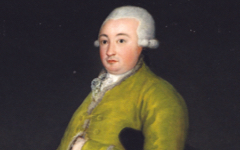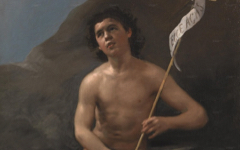Goya’s and Dix’s Scenes of Execution
Goya’s The Third of May, 1808 was the second of a pair of paintings about a rebellion against the French occupation in the streets of Madrid.
Click next thumbnail to continue
The first titled The Second May, 1808 depicts the street fighting of the day before (left) and has already been revealed here as the scene itself being “painted” in a studio. A figure representing Goya, dagger in hand, faces into the painting in the lower right corner and “paints” the scene in front of him.1 Thus, the subject of The Third of May is likely to be similar, not least because Manet’s masterpiece, The Execution of Emperor Maximilian, was inspired by it and veils a similar meaning.
In both paintings, Manet’s and Goya’s, the firing squad are too close to their target for a real execution. It is one of those visual inconsistencies that only the concept of every painter paints himself can explain. The soldiers are the "artist" close to their "canvas" painting it. Sarah Symmon’s observation that the Goya has “a strong reliance on slightly flattened perspective”2 is another inconsistency. It suggests, though, that the space behind the soldiers must have been flattened for a reason: to represent the “painting” itself, a flat piece of canvas.
The light from the lamp, moreover, shines through opaque glass much like the north light of a studio window. And the man with arms outstretched like Christ on the Cross and with unexplained stigmata on his hands echoes that of the man on the ground who, it has been argued by specialists, is the same figure that we identified in Second of May as the “artist” himself.3 Thus Goya in conceiving his masterpiece has imagined his creative soul as Christ because, without such divinity, how else could he have conceived his masterpiece? Goya is not known to have been particularly religious but that never stopped an artist from portraying himself as Christ and God.4
Otto Dix used Goya’s and Manet’s example for the same purpose, the depiction of an historical event close to home, the uprisings in the streets of Berlin and their violent suppression by the forces of order. The painting was lost and presumably destroyed during World War Two so a recent essay by James Van Dyke is the only important analysis of it. The author has no idea of its underlying meaning but does observe that the victims are neatly parallel to the picture plane, again suggesting the flatness of a canvas.5
The proof of this interpretation is in the use of Dix’s monogram. It is placed not with the rebels on the street, the side he supported, but on the hand grenade of the nearest soldier, a representative of the side Dix detested.5 The firing squad are the artist "painting" their victims with their weapons as brushes. Manet, as we revealed some time ago, did the same in using French imperial troops as the “artist” in his canvas, a symbol of the government he disliked. Artists do not place moral values on good and evil because they recognize that there is good and evil in all of us and both, in certain ways, are beneficial. Good (and heaven) symbolize logic, reason and the imposition of order on chaos; evil (Hell) represents the chaos of the creative mind and the random connections chaos makes between seemingly dissimilar events. Chaos is the essence of creativity; order, its "execution."
Picasso, who must have been thinking of paintings like these in which a weapon is used as a "paintbrush", once said: "Nine times out of ten, when a painter says to you: "No, that canvas isn't quite finished....there's a little something missing....I'll have to finish it off....well, he'll finish it off. You know, the way they finish off people executed by a firing-squad. With a revolver-shot in the head."6
Notes:
1. For a fuller explanation, see the entry itself: Goya's Second of May, 1808
2. Sarah Symmons, Goya (London: Phaidon) 1998, p.262
3. Symmons, op. cit., p.265
4. See the themes: The Artist as Christ and The Divine Artist.
5. James Van Dyke, “Otto Dix’s Streetbattle and the Limits of Satire in Düsseldorf, 1928”, Oxford Art Journal 32, Jan. 2009, pp. 37-65
6. Hélène Parmelin, Picasso Says.... (New York: A.S. Barnes & Co.) 1966, p. 106
Original Publication Date on EPPH: 01 May 2011. | Updated: 0. © Simon Abrahams. Articles on this site are the copyright of Simon Abrahams. To use copyrighted material in print or other media for purposes beyond 'fair use', you must obtain permission from the copyright owner. Websites may link to this page without permission (please do) but may not reproduce the material on their own site without crediting Simon Abrahams and EPPH.








